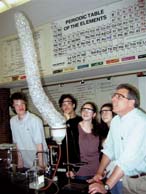from Laura Slocum, JCE High School Associate Editor
New has been defined in various ways—recently made, created, or invented; recently discovered or noticed; recently introduced and previously unfamiliar; at the beginning of another day, month, or year. At this time of year most of us are probably thinking about this last definition of new. However, for me right now it means changed, especially changed for the better. I have rewritten my Chemistry and AP Chemistry curricula for this school year, reordered many of the topics, and put in several new labs and projects. I am really looking forward to what these “new” changes will bring to my classes.
What does new mean to you? The September 2008 issue of the Journal of Chemical Education contains a number of interesting “new” ideas that can be used in our classrooms in a variety of ways this year. In the Classroom Activity Connection, Linda Fanis points out a number of new Web sites that contain valuable information related to color—the Tie-Dye Wiki connection gave me additional information to include in the spring semester of my chemistry course and the General Chemistry Online Acids and Bases: FAQs Web site will be a valuable resource for both my Chemistry and AP Chemistry students.
Forces of attraction between particles, especially intermolecular forces of attraction between the various types of molecules, can often be a stumbling block for students. Jasien provides several alternative ways to help students assess the relative strength of these different types of intermolecular attractions. I am looking forward to trying his approach, especially with my AP Chemistry students this fall.
I am always looking for new lab ideas, so Belle-Oudry’s use of EDTA to determine the concentration of sulfate ions using an indirect titration method really appeals to me. I want my AP Chemistry students to have unique lab experiences that are different from those of their first-year. I think this idea provides a nice extension to titration, and uses materials that are readily available to high school teachers. I plan to use this lab in October.
There is one article in this issue that does not contain “new” ideas for the classroom, but I think it contains something even more important—encouraging, uplifting, insightful words from a teacher who poured out his heart to those of us at the High School Program at the ACS National Meeting last April in New Orleans: Richard Goodman, the 2008 Conant Award recipient. The energy and enthusiasm Goodman shared with each of us that day, he shares with each of you through his interview with the JCE Editorial Staff. His words reminded me why I do what I do and why it is so very important: it is not for the administration, the parents, or even myself—it is for the students whose lives we get to touch for the brief moments in time that we have them in our classrooms. Some of them we never change and some of them we change forever.
I hope that this year brings you the very best and that each of us touches at least one student’s life forever. Have a great school year!
Richard Goodman, 2008 Conant Award recipient, demonstrates for his students. Photo by Shailaja Iyer.
Erica’s Take on the Issue
from Erica Jacobsen, JCE High School Editor
Laura has described Goodman’s presentation at the High School Day program in New Orleans this past spring. Unfortunately, I was not able to attend and see him in person. However, I agree that his interview in this issue really shares the flavor of his personality, teaching style, and love for chemistry. Goodman commented on his appreciation for the summer Biennial Conferences on Chemical Education and the ChemEd conferences, often combining his attendance with a family vacation. Our family has done the same at these and ACS conferences, and it’s given us an excuse to drive to many new places that we wouldn’t normally have been able to visit—Vancouver, Washington, DC, Toronto, and Auburn, AL (with a stopover at Graceland!).
This issue provides two more opportunities to travel and “see” new places—without even leaving your home. Coppola shares his experience connecting with chemistry educators in Indonesia, while Chao and Churchill describe common Chinese chemical terms and characters. There are even audio files of the chemistry vocabulary terms, to get a feel for the spoken language. It’s a chance to learn something new about the experiences and lives of your colleagues, even those around the world.




* You can follow any responses to this entry through the RSS 2.0 feed.